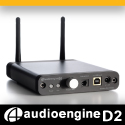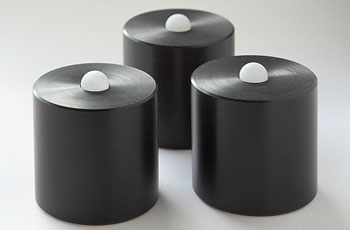|
|
You are reading the older HTML site
Positive Feedback ISSUE 65
allnic audio HA-3000 Head Amplifier as reviewed by Marshall Nack
In the course of reviewing (and subsequently purchasing) Allnic's H-3000V Phono Preamp, I happened upon their HA-3000 Head Amp. Don't know what a head amp is? That's not too surprising. Background Info Back in the late 1970's/early 1980's, when moving coil cartridges were introduced, there weren't many phono preamps with sufficient gain to handle ultra low-level signals. Thus the "head amp" was born, a niche product in the signal chain between the turntable and the phono preamp to boost the MC signal before it reached the phono stage. Today, most phono stages are designed with MC carts in mind. But, there are good reasons for moving amplification to an external chassis. Noise is always a problem when you're dealing with phono-level signals. Any noise will be magnified, much more so than with other source components. That's why moving the amplification to an external box makes sense. Head amps don't get much traction, at least not in the USA. They never went out of popularity in Japan, and the Allnic importer informs me sales are also good in Canada and Europe. The HA-3000 Head Amp The all-tube Allnic HA-3000 Head Amp is comprised of two small chassis and uses a pair of NOS 7895 Nuvistors from the 1960's for amplification. I was surprised to learn there were many varieties of these tiny tubes, the smallest vacuum tube ever manufactured.
Because of their age and tiny pin size, Nuvistors are particularly sensitive to dirt or corrosion. Extreme care must be exercised.
Vintage Nuvistor tube sockets from the 1960's proved too noisy, so Allnic designed custom tube sockets for the tiny valves (which incorporate Absorb-Gel® socket damping). The Nuvistors, along with other sensitive circuitry, are mounted on a board with a four-point rubber suspension/shock system. BTW: Allnic wasn't the first to use Nuvistors in a head amp: Conrad Johnson had such a product back in the late 1970's. The second chassis, an external power supply, contains a pair each of 7233 and 6BH6 tubes. These are also NOS, usually General Electric or Westinghouse brands. Functionally, the main difference is active amplification versus the passive amplification provided by step-up transformers in the H-3000V.
HA-3000 Power Supply Installation When the HA-3000 arrived at my place it must have been jostled in transit: one channel was out. It was necessary to open it up and re-seat the Nuvistors. Once that was done, the unit worked flawlessly. So, now glancing up at my rack, I was looking at two chassis for my Allnic H-3000V plus two more for the HA-3000—four chassis just to handle phono amplification! (Not to mention the extra power cord and IC.) You gotta love it. Impressions
The telltale clues are all present in the first minute or two of Brahms Trios, a rather fine, late Harmonia Mundi LP set by the noted engineer Jean-Francois Pontefract (HM 1063/64). In those instances when pianist Jean-Claude Pennetier does not depress the damping pedal and lets the note ring, you hear the hammer hit followed by the fundamental note for a certain duration. Then the overtones kick in. With the Head Amp in line, this is clearly observed as two distinct events. The break is so clean, it's kind of eerie. Then, you are privy to the different decay rates of the overtone components. I've occasionally heard something like this when I'm sitting up close in recital rooms that are really quiet and a bit dry (and usually sporting a fair amount of acoustic damping as well). When the decay is gone, there's complete silence. With the H-3000V alone, the hammer hits; the fundamental begins and it blends seamlessly with the overtones—you can't tell where the fundamental ends and the overtones begin—and it all decays together. You don't hear the component makeup of the decay. And when it's done, the space doesn't feel empty.
Another example: Pas de Deux (Decca, SXL 6137). With the HA-3000, you can tell the off-pitch notes are coming from the second French horn at the beginning of Pas Classique, track one on side two, a surprising performance issue for the London Symphony Orchestra. They stick out like a sore thumb and stand apart from the first chair player. This was even more evident when I swapped in the Dynamic Design Nebula THB Power Cord, with its SOTA front-of-hall resolution. Now I can tell you the principal French horn is the shaky one, the second has the intonation problem, and I think there's even a third and fourth horn lurking in the background. (I would have to check the score to be sure about that.) Just after the French horn melody, there is a hard-hitting orchestral tutti, followed by another horn solo, with the second part still struggling. There's no place to hide with the HA-3000 powered by the Dynamic Design Nebula. Without the HA-3000, you know there's less than perfect intonation, but it's not clear what is causing it. One final example of a non-musical sort. Dyed-in-the-wool vinylphiles know there's lots to learn from the way a front-end handles tics and pops. Where is this noise located? Is it fixed at the speakers or does it move around with the music? Placement of these was about the same with either machine. Is it soft or hard? Tics and pops hit harder and are more prominent through the HA-3000. (And yes, when I think about it, the H-3000V had a marginal problem with overall softness, a trait often associated with step-up transformers.) What is the tone of these noises? They are a white noise. Through the H-3000V, they are midrangy, another trait often associated with step-ups. These examples tell you succinctly how the HA-3000 handles the signal. Put into my mild-mannered mode of expression, with the HA-3000 in line, music fairly explodes from the speakers. For the average listener, it's quite spectacular. Dynamics pop and selective notes project into the room in a holographic manner. The soundstage grows dimensionally and images become distinct, both from left to right and within closely seated instruments. Their tone concentrates; they become dense and massive—there's added resolution that does not come at the expense of body mass. Meanwhile, the peaks of the action stay clear and undistorted even as they hit higher SPLs. The HA-3000 so overwhelmed the sound of the H-3000V alone, I had to structure my demos to make sure the H-3000V came first.
Inside the Power Supply What's Expected? These things were expected—but not to this degree. Because the HA-3000 is active, I figured the sound would be more forceful and the ante for soundstaging would be upped. I also assumed there would be more etching, more noise and distortion byproducts. And there is a tad more background noise (though not enough to be an issue). However, no distortion byproducts are evident, and no one on my panel ever used the adjective "etched." SIDEBAR: These two things, the low levels of background noise and distortion, speak volumes about the design of the HA. These are not easily achieved in a component of this nature. More Expectations But I also expected I would lose the mobile musical line and the credible dynamic relationships with the step-up transformers taken out of the signal path. This happens to a degree, but not enough to warrant complaint. However, for some very astute listeners, the presentations have a different feel. You lose the ease and effortless quality, that feeling of humans interacting on the stage. You sense there is more editing going on. In short, the H-3000V is no longer outstanding for its unembellished, untampered naturalism. There were some members of my panel who felt this was too high a cost. For the majority, however, there was no contest. This is the analog sound audiophiles are striving for. Lynn summed it up nicely: The HA-3000 tells you what the mic heard; The H-3000V, with the step-ups, tells you what the instruments sounded like in the performing space. Burn-In A funny thing happened on the road to burn-in. I was told the HA-3000 had been used and only needed minimal burn-in/settling time. The first week, it sounded like a classic tubed phono stage: lower midrange heavy, very fulsome, and kinda bloated. Then, quite by accident, it changed. I needed to put some hours on a CD player and took the opportunity to spin the Granite Audio CD-101 Phono Burn-In disc on the player while feeding its output into the HA-3000. I left it on repeat for about four hours. Ah, stupido! Not realizing it, this amounted to feeding a MM signal into the HA-3000, which expects to be fed an exponentially smaller MC signal! But the result was salubrious. When I spun the next LP, the sound was transformed. All of those classic tube attributes disappeared: the response curve straightened out and hewed much closer to neutral. (Please check with distributor/manufacturer before attempting this at home.) As far as burn-in, my advice is PROCRASTINATE. No assessment should be undertaken before the unit has 100 hours on it. (And this applies as well for the H-3000V.)
Setup The HA-3000 accepts single-ended (RCA) inputs from your phono cable. It has one pair of single-ended (RCA) outputs for an interconnect to the MM inputs of your phono preamp. The HA-3000 has four input load impedances: 50, 100, 200, and 500 ohms, selectable from a rotary dial on the front panel. I set loading to the 500 ohm detent, per the importer's recommendation, and found it to work best. Voltage gain is fixed at 30 dB, which is suitable for MC cartridges with output from .5mv down to .2mv (depending on the efficiency of the rest of the system). As with the H-3000V, power conditioning is not recommended. Splendid results were achieved with both Kubala-Sosna Elation! and the Dynamic Design THB Nebula power cords. Signal wires were Elation! RCA interconnects and Emotion phono cable. Tweaks
edenSound TerraStone Rollers I suspected edenSound TerraStone Rollers were a good choice under the power supply or the main chassis, based on what these footers did for the H-3000V. And how! Dynamics exploded when a set was place under the power supply. The bottom end became tighter, focus locked in, and images stopped moving about—still with no etched borders. Conclusion When I reviewed the Allnic H-3000V Phono Stage, I thought it was about the equal of my then-reference ASR Basis Exclusive on the standard audiophile grading criteria. But its most vaunted characteristic is not to be found on those charts. The H-3000V achieves a very rare effortless naturalism by incorporating off-the-beaten-path design choices, including step-up transformers, a passive means of amplifying the miniscule output of an MC cartridge. Alternatively, for those consumers who want it, Allnic offers an active means of amplifying the MC signal: the HA-3000 Head Amp. When you put the HA-3000 Head Amp in front of the H-3000V, everything on the audiophile wish list gets a boost: dynamics, sound-staging, imaging, dimensionality—you name it. It leaps past the ASR and becomes what everyone reading Stereophile magazine wants in an analog front-end. Ah, but not quite everyone. There was a sizable minority of listeners who bemoaned the loss of the H-3000V's effortless naturalism. With the HA-3000 Head Amp, the sound moves closer to conventional tubed phono preamps. Correction: make that the best of the conventional tubed phono preamps. The choice is yours. Marshall Nack
Allnic
HA-3000 Head Amp
Allnic
Audio Labs , South Korea Importer
Hammertone Audio |










